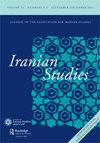“国王之家成为人民之家”:巴列维王朝博物馆讲述伊朗现代史
IF 0.9
4区 社会学
Q2 AREA STUDIES
引用次数: 0
摘要
摘要本文考察了巴列维王朝博物馆,该博物馆于1976年在纪念巴列维统治50周年的庆祝活动中落成。这座博物馆建在德黑兰市中心国王的故居——大理石宫内,旨在纪念巴列维王朝的成就,展示巴列维王朝官方版本的伊朗现代史。这座博物馆在许多方面都是独一无二的,尤其是因为它是巴列维王朝唯一一座被改造成博物馆以纪念巴列维家族的前宫殿,但它与这一时期建造的其他博物馆有着共同的目标。在巴列维统治后期,国家文化政策的一个主要方面是支持加强官方叙事的倡议,这种叙事认为巴列维家族是2500年君主传统的合法继承人。本文探讨了国家如何试图通过博物馆的设计和展览来表达这些叙事。本文章由计算机程序翻译,如有差异,请以英文原文为准。
“The Shah's House Became the People's House”: Narrating Iran's Modern History at the Pahlavi Dynasty Museum
Abstract This paper examines the Pahlavi Dynasty Museum, which was inaugurated in 1976 during the celebrations marking the fiftieth anniversary of Pahlavi rule. Built inside the Marble Palace, the shah's former residence in the center of Tehran, the museum was intended to memorialize the achievements of the Pahlavis, presenting the official Pahlavi version of Iran's modern history. The museum was unique in many respects, not least because it was the only former Pahlavi palace that had been converted into a museum to honor the Pahlavis, but it shared the objectives of other museums constructed during this period. During the late Pahlavi era, a major aspect of the state's cultural policy was to sponsor initiatives that strengthened the official state narrative, which argued that the Pahlavis were the legitimate heirs of a 2500-year-old monarchical tradition. The article explores how the state attempted to express these narratives through the museum's design and exhibits.
求助全文
通过发布文献求助,成功后即可免费获取论文全文。
去求助
来源期刊

Iranian Studies
Multiple-
自引率
0.00%
发文量
92
期刊介绍:
Iranian Studies is a peer-reviewed journal devoted to Iranian and Persian history, literature, and society, published on behalf of the Association for Iranian Studies . Its scope includes all areas of the world with a Persian or Iranian legacy, especially Iran, Afghanistan, Central Asia and the Caucasus, and northern India, and Iranians in the diaspora. It welcomes submissions in all disciplines.
 求助内容:
求助内容: 应助结果提醒方式:
应助结果提醒方式:


